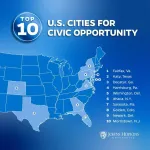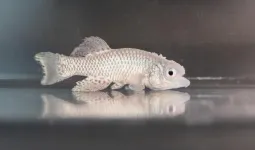(Press-News.org) People in many parts of the United States possess few chances for the robust community engagement that underpins healthy democracies, according to a new report that for the first time maps civic opportunity across the country.
The heat map created by Johns Hopkins University’s SNF Agora Institute, reveals patterns of inequality in civic opportunity tied to race, class, immigration status and education. Researchers also found that a great deal of civic engagement happens through local faith institutions and social and fraternal organizations, not D.C.-based advocacy organizations that tend to carry political clout.
The report is the initial phase of an ambitious effort to map the modern agora, referring to the lively assembly places of ancient Greece often considered to be the birthplace of democracy. The work is published in Nature Human Behaviour.
“If you want to strengthen civic engagement, the first thing you have to do is map what the civic infrastructure of the United States looks like. You can’t fix what you can’t see,” said Hahrie Han, director of the university’s SNF Agora Institute and a professor of political science. “First you have to be able to see a picture of the whole, then you can figure out how you target investments to catalyze the kind of reforms that we need to rebuild the modern-day agora.”
The team worked with big data and computational tools to develop a more precise map of civic opportunity than previously possible. They started with non-profit organizations registered with the Internal Revenue Service—1.8 million of them. To learn more about the groups and where they operate, the team layered that information with data from more than 1 million organizational websites and the U.S. Census. They then identified and classified the organizations actually generating true civic opportunity—coming up with 564,559 groups.
Civic opportunity scores per capita decreased as poverty levels increase, the team noticed, and wealthier, whiter, better-educated communities were more likely to have civic opportunity. They also found that inequality in civic opportunity affects a community’s ability to come together to solve problems, such as forming mutual aid organizations during the pandemic and decreasing vaccine hesitancy.
For instance, every county in Connecticut is among the highest providers of civic opportunity but most of Mississippi is among the lowest.
“What we find is that there are patterns of inequality in civic opportunity based on things like race, class, immigration status, and education. So wealthier, whiter communities are likely to have more civic opportunities than poorer, less white communities,” Han said.
The most common organizations providing civic opportunity across America are religious organizations and social-fraternal organizations (such as Rotary clubs, fraternities, ethnic clubs, and religious groups), which together make up 37% of all civic opportunity organizations. In 85% of counties, they are the top providers of civic opportunity.
“One of the things that was surprising was the extent to which the highest providers of civic opportunity are still faith institutions and social and fraternal organizations,” Han said. “The kind of organizations that tend to be talked about in public affairs and politics tend not to be the kind of organizations providing civic opportunities to people across America. I’m in many, many conversations with democracy reform people and I can’t think of a single person who’s said we’re going to go find the bridge players of Topeka, but that’s where people are engaging with other people.”
Because it’s clear that the groups providing civic opportunity are vastly decentralized, the question becomes how to reach these people, Han said.
“It’s encouraging that there are places where people are still gathering,” she said. “To me the problem isn’t the places people are gathering, it’s that the political elite are ignoring those places. The first rule in trying to engage people in democracy is that you have to meet people where they are.”
The team plans to make the data publicly available and ideally searchable by ZIP code so that people can find these organizations within their communities.
The Johns Hopkins team also included associate research scholar Milan de Vries and research fellow Jae Yeon Kim.
END
New heat map charts unequal civic opportunity in the US
2023-11-13
ELSE PRESS RELEASES FROM THIS DATE:
One step closer to Mars immigration
2023-11-13
Immigration to and living on Mars have long been depicted in science fiction works. But before dream turns into reality, there is a hurdle man has to overcome -- the lack of essential chemicals such as oxygen for long-term survival on the planet. However, hope looms up thanks to recent discovery of water activity on Mars.
Scientists are now exploring the possibility of decomposing water to produce oxygen through electrochemical water oxidation driven by solar power with the help of oxygen evolution reaction (OER) catalysts. The challenge is to find a ...
National survey indicates more young adults begin tobacco use with vaping, not cigarettes
2023-11-13
Young adults are now more likely to vape than to use traditional cigarettes. After years of public health success in decreasing the numbers of people using cigarettes, researchers are seeing striking increases in the numbers of young people who use e-cigarettes regularly – so much so that, for the first time, there are more young people who begin to use nicotine through vaping rather than through cigarettes.
“We now have a shift such that there are more ‘never smokers’ who vape than established smokers,” ...
Widening gender gap in life expectancy in the US
2023-11-13
About The Study: This analysis finds that COVID-19 and the drug overdose epidemic were major contributors to the widening gender gap in life expectancy (nearly six years) between women and men in recent years. Men experienced higher COVID-19 death rates for likely multifactorial reasons, including higher burden of comorbidities and differences in health behaviors and socioeconomic factors, such as labor force participation, incarceration, and homelessness. Differentially worsening mortality from diabetes, heart disease, homicide, and suicide suggest that chronic metabolic disease and mental illness may also contribute.
Authors: Brandon W. Yan, M.D., ...
Shift from smoking cigarettes to vaping nicotine in young adults
2023-11-13
About The Study: The data from this nationally representative survey study reveal a shift in tobacco use among young adults (ages 18-24), showing historically low cigarette use, which has positive public health significance. However, e-cigarette use is higher (14.5%) than reported previously, coinciding with the introduction of salt-based devices in 2015 to 2018. Over half of established vaping young adults never regularly smoked. Research suggests that exclusive e-cigarette users are unlikely to ...
Trends in prevalence of breastfeeding initiation and duration among US children
2023-11-13
About The Study: The findings of this study indicate an increase in the prevalence of breastfeeding initiation and breastfeeding duration at 12 months from 1999 to 2018 in the U.S. Temporal changes of breastfeeding duration at 12 months were more prevalent among male infants, older mothers, Mexican American and multiracial participants, and households with higher income.
Authors: Yongjun Zhang, Ph.D., M.D., of the Shanghai Jiao Tong University School of Medicine in Shanghai, is the corresponding author.
To access ...
Study finds melatonin use soaring among youth
2023-11-13
Nearly one in five school-aged children and preteens now take melatonin for sleep, and some parents routinely give the hormone to preschoolers, according to new research from the University of Colorado Boulder published Nov. 13 in JAMA Pediatrics.
This concerns the authors, who note that safety and efficacy data surrounding the products are slim, such dietary supplements lack full regulation by the Food and Drug Administration.
“We hope this paper raises awareness for parents and clinicians, and sounds the alarm for the scientific community,” said lead author Lauren Hartstein, PhD, a postdoctoral fellow ...
How good can overpower evil in the genetic determination of Alzheimer’s disease
2023-11-13
San Francisco—November 13, 2023—Researchers at Gladstone Institutes have discovered that a rare genetic variant known as the “Christchurch mutation” can block detrimental effects of apolipoprotein E4, the best-established risk factor for the most common form of Alzheimer’s disease.
The apolipoprotein E (APOE) gene has long been known to affect the risk of Alzheimer’s disease through its three main variants: E2 (low risk), E3 (intermediate risk), and E4 (high risk). More recently, a ...
Recreation of ancient seawater reveals which nutrients shaped the evolution of early life
2023-11-13
Scientists know very little about conditions in the ocean when life first evolved, but new research published in Nature Geoscience has revealed how geological processes controlled which nutrients were available to fuel their development.
All life uses nutrients such as zinc and copper to form proteins. The oldest lifeforms evolved in the Archean Eon, three and a half billion years before the dinosaurs first appeared. These microbes showed a preference for metals such as molybdenum and manganese compared to their more recent counterparts. This ...
Cycle of fasting and feeding is crucial for healthy ageing
2023-11-13
Fasting interventions, which involve alternating periods of fasting and refeeding, are generally thought to improve health. But these interventions don’t work as well in old animals. The question is: Why? By studying the short-lived killifish, researchers at the Max Planck Institute for Biology of Ageing in Cologne have shown that older fish deviate from a youthful fasting and refeeding cycle, and instead enter a state of perpetual fasting, even when ingesting food. However, the benefits of refeeding after fasting in old killifish can be restored by genetically activating a specific subunit of AMP kinase, an important sensor ...
How climate change could be affecting your brain
2023-11-13
A new element of the catastrophic impacts of climate change is emerging – how global warming is impacting the human brain.
In a paper published today in Nature Climate Change, an international team of academics explore the ways in which research has shown that a changing environment affects how our brains work, and how climate change could impact our brain function in the future. The paper is led by the University of Vienna with input from the universities of Geneva, New York, Chicago, Washington, Stanford, Exeter in the UK and the Max Plank Institute in Berlin. It also explores the role that neuroscientists can play in further understanding and addressing ...





